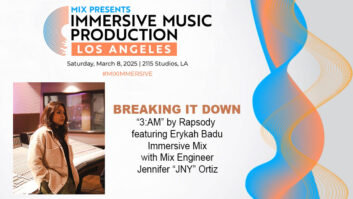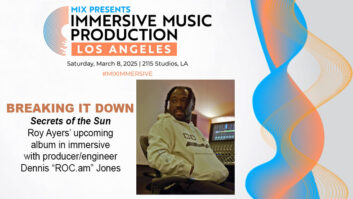
Hartford, CT (October 13, 2023)—Scott Metcalfe, Chair of Music Engineering and Technology at The Peabody Institute of Johns Hopkins University in Baltimore, Md., recently engineered and co-produced a live immersive recording session of the Voce Chamber Choir at Immanuel Congregational Church in Hartford, Conn.
“This was a multi-day recording session,” Metcalfe explained. “I’ve done a lot of live performance and studio session recordings with this group over the years; this time, it was for a release of music by British composer Patrick Hawes. When recording a choir of Voce’s caliber, my goal is to capture a balanced vocal blend where individual voices don’t stick out, while maintaining enough articulation for the text to be understood by the listener. The ratio of direct to reverberant sound depends on a number of factors, with the primary considerations being how the room complements the music and the subjective preferences of the conductor, Mark Singleton, the composer and myself.”

Describing the technical setup, Metcalfe added: “There are seven primary microphones that correspond to each of the monitors in a 7.1 configuration, comprising three in front, two to the sides and two behind. Four Telefunken small-diaphragm FET condenser M60s with hypercardioid capsules are placed in coincidence with the L-R and Ls-Rs mics, but aimed upward to capture ‘height’ information. These ceiling reflections are reproduced through the speakers that are above your head aiming down, creating a really immersive experience—where you feel like you’re in the space where the music was being performed. Everything was directly tied to this Atmos rendering of the performance, but with careful attention to a fully compatible stereo version for the initial release.
Fairchild 670 Tube Compressor Goes Back into Production
“The modified tree configuration is made up of ELA M 260s with TK61 omni capsules,” he continued. “The vertically aimed mics are the FET version of their small-diaphragm M60 FET with TK62 hypercardioid capsules for picking up ceiling reflections for the Atmos height channels, and providing additional natural reverberation in the stereo mix, particularly useful for tracks with pipe organ accompaniment.”
Elaborating on the NOS setup, Metcalfe said, “I used the two cardioid TF51s spaced 30 centimeters and aimed 90 degrees apart. Although the spacing is roughly twice the width of the average adult human head, the rejection of the angled cardioids and the inherent time-of arrival differences offer a capture that is similar to what you would hear with your head in the same location.”
To record the choir, Metcalfe turned to Metric Halo. “The older 2882 interfaces have been upgraded from FireWire to USB-C, and more processing power has been added, as well as Metric Halo’s proprietary audio-over-IP and control system called MH Link,” he explained. “All of the preamps used on this recording are from a combination of their newer ULN-8 interface for the primary channels—due to its abundant, clean gain and excellent A/D conversion—and the 2882s for closer mics needing less amplification.”
The experience was both energizing and somewhat special for Metcalfe: “Voce is based in Hartford, and I’m originally from Hartford. Telefunken’s headquarters are in South Windsor, the town adjacent to Hartford. I thought it would be cool for this Hartford-based group with an original Hartford recording engineer and the microphone’s coming from nearby.
We ended up with 13 Telefunken microphones, and I added my two M60s to create the Atmos configuration that I was going for, as well as a stereo pair that was a spot for the choir. We got it dialed in, and the composer and conductor were very happy with it.”







